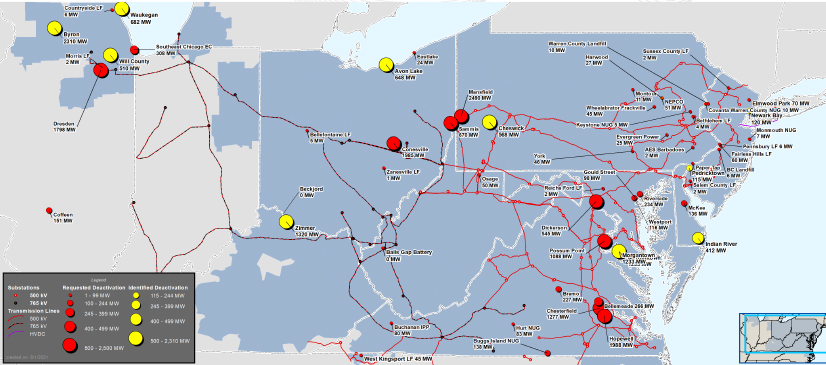Winter/Light-Load Generator Deliverability Update
PJM is looking to modify generator deliverability tests for light-load and winter periods as more renewable energy is set to come online in the coming years.
Jonathan Kern of PJM’s transmission planning department provided an update on the winter and light-load generator deliverability analysis and the proposed changes to the generator deliverability test for the light-load and winter periods at last week’s Planning Committee meeting.
Kern said the purpose of the changes is to “consider the rapidly evolving” resource mix in PJM’s planning process and to “support operational flexibility” by planning the grid to handle the expected evolving resource mix.
PJM is looking to modify each of the generator deliverability tests, Kern said, but wanted to start with the light load and winter generator deliverability procedures. Kern said those procedures have been “relatively unchanged” for many years and need better accounting for the expected higher variability of renewable resources in dispatching.
The current light-load procedure starts with a load level at 50% of the annual peak, Kern said, and is representative of November through April and the hours of 12-5 a.m. PJM is proposing to keep 50% of the annual peak but wants to shift the definition of the period of the light load to use load hours between 40% and 60% of the annual peak and to also use daytime hours and other periods of the year reaching the same 50% load level.
Kern said the change in hours is driven by the addition of solar power in the daytime hours and not simply looking at wind resources as PJM had done in the past for the light-load procedure.
“We’re currently not accounting for solar in the light-load test because it’s focused on the nighttime period,” Kern said. “So we want the light-load test to cover a broader set of hours.”
For the ratings in the light-load procedure, PJM is proposing using 59 F as the default temperature set. The light-load procedure currently uses 95 F as the default, which PJM determined is “too conservative,” Kern said.
He said PJM planning engineers spoke with several subject matter experts in operations and markets to look at historical dispatch patterns and conducted a “significant amount of testing” to develop several proposals to modify the base case dispatch, the external and internal interchange and generator ramping procedures for both winter and light-load.
PJM is still working on proposal assumptions by conducting additional analysis, Kern said, and is formulating updated language in Manual 14B to be brought to the PC for the first read before the end of the year.
Carl Johnson of the PJM Public Power Coalition asked if PJM will issue a report to give stakeholders more insight into the nature of the proposed changes and what could be expected in the future as more renewables come online.
Kern said developing the grid of the future will be one of PJM’s primary focuses over the next few years and it will be issuing white papers and reports on how the grid will need to evolve and what the RTO’s role will be in its evolution.
Manual 20 Endorsed
Stakeholders unanimously endorsed the cover-to-cover updates of Manual 20: Resource Adequacy Analysis.
Patricio Rocha Garrido of PJM’s resource adequacy department reviewed the revisions to the manual, saying the minor changes included cleaning up outdated and redundant language and ensuring the manual language follows current PJM processes. The changes were first introduced at the June PC meeting. (See “Manual 20 First Read,” PJM PC/TEAC Briefs: July 13, 2021.)
The changes included removing the Reliability Pricing Model (RPM) timeline from section 1.2 of Manual 20 because it already exists in Manual 18 and clarifying language around the time period used in the creation of the load model and aspects of the capacity model in section 3.2.
Rocha Garrido said one complication in the Manual 20 changes was a parallel effort at the MRC to update the manuals resulting from discussions addressing the effective load-carrying capability (ELCC) for limited-duration and intermittent resources. Stakeholders endorsed the revisions at the July Markets and Reliability Committee meeting. (See “ELCC Manuals,” PJM MRC/MC Briefs: June 23, 2021 and “Consent Agenda Manual Endorsements,” PJM MRC/MC Briefs: July 28, 2021.)
The ELCC changes were in section 5 of Manual 20, Rocha Garrido said, which include an overview of PJM’s ELCC analysis, a description of the load model used and a description of the loss of load expectation calculation.
Members will be asked to endorse the changes at the Aug. 25 MRC meeting.
Manual 14G First Read
Terri Esterly, senior lead engineer for PJM’s markets automation and quality assurance department, provided a first read of updates to Manual 14G: Generation Interconnection Requests regarding the behind-the-meter generation (BTMG) business rules on status changes.
Esterly said the changes were the result of work done at special sessions of the Market Implementation Committee to review the existing BTMG business rules and identify gaps in the rules. Esterly presented related changes to Manual 14D at the August Operating Committee meeting. (See “Manual 14D Updates,” PJM Operating Committee Briefs: Aug. 12, 2021.)
The updates include language on megawatts changing status from BTMG, where they can net against the load, to the PJM market resource status. Esterly said the updates were intended to address conflicts with the Reliability Pricing Model (RPM) must-offer requirement and removal from generation capacity resource status business rules as well as to clarify and “adequately document” the processes related to status changes.
Esterly said most of the updates to the manual are in section 1.6.1 to clarify information required in an interconnection request to designate capability as a generation capacity or energy resource. The updated language includes a list of information required in a new services request for a BTMG unit, a definition of behind-the-meter load and a clarification on how to determine the maximum host/process loads.
The committee will be asked to vote on the manual changes at the Aug. 31 PC meeting.
Transmission Expansion Advisory Committee
Generation Deactivation Notification
Phil Yum of PJM provided an update on 14 recent generation deactivation notifications totaling nearly 8,000 MW at last week’s Transmission Expansion Advisory Committee meeting.
Houston-based GenOn Holdings requested the Sept. 15 deactivation of the 627-MW coal-fired Avon Lake 9 Generating Station and 21-MW oil-fired Avon Lake 10 unit, both located in Ohio’s American Transmission Systems Inc. (ATSI) transmission zone, and the 568-MW coal-fired Cheswick Generating Station, in the Duquesne transmission zone in Pennsylvania.
GenOn also requested the May 31, 2022, deactivation of 1,233 MW from the coal-fired Morgantown Generating Station units 1 and 2, located in the PEPCO transmission zone in Maryland.
Yum said a reliability analysis for all five units identified some reliability violations but that new and existing baseline projects will “resolve” the identified impacts and the units can retire as scheduled.

Exelon requested that its two Byron nuclear units, both in the ComEd transmission zone in Illinois, be deactivated Sept. 14 and 16. The company originally announced in 2019 its intention to retire the units. It then reiterated its intention before the Illinois legislature failed to pass an energy package that would support the plants. (See Biden’s Support for Nuclear ‘Too Late’ to Save Exelon Plants.)
Yum said a reliability analysis identified fixable issues for both Byron units and that they can retire next month.
NRG Energy requested that the coal-fired Waukegan Generating Station Units 7 and 8 and the 510-MW coal-fired Will County Generating Station Unit 4, all located in the ComEd zone, be deactivated on May 31, 2022. Yum said a reliability analysis was completed and the units can retire as scheduled.
NRG also requested a May 2022 deactivation of its coal-fired 412-MW Indian River 4 Generating Station, but the reliability analysis identified the need to keep the plant operating. Yum said PJM identified seven different thermal violations, estimated to cost $117.4 million. PJM and NRG are working on solutions to allow for deactivation.
PJM also received generation deactivation notices for three additional units for May 31, 2022, including Talen Energy’s 115-MW gas- and oil-fired Pedricktown Power Plant in the Atlantic City Electric transmission zone and the 120-MW Newark Bay Power Plant in the Public Service Enterprise Group transmission zone, as well as Vistra’s 1,320-MW coal-fired William H. Zimmer Power Plant in the Duke Energy Ohio/Kentucky transmission zone. Yum said a reliability analysis is underway for each unit.
A total of 7,918 MW of generation is set to be deactivated.



